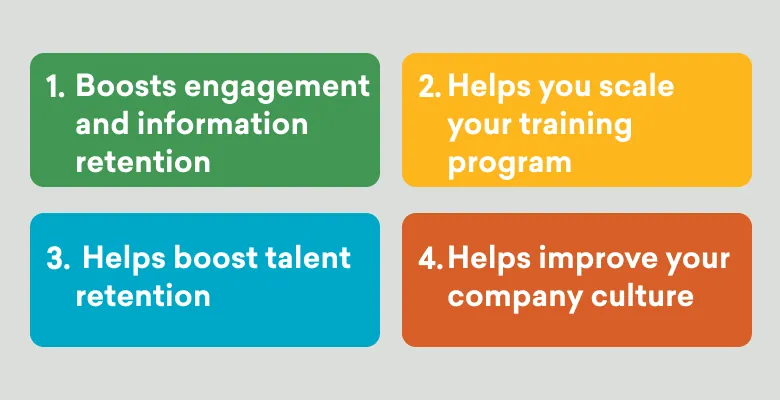[ad_1]
$(function()
$(“body”).prognroll(
height: 8, //Progress bar height in pixels
color: “#00a1cc”, //Progress bar background color
);
);
In a world of constant change, effective employee training is critical. In this post, you’ll learn about the value of great training videos and how to make them.
Table of contents
The value of great training videos
Popular types of training videos for business
How to make a training video from start to finish
Benefits to producing training videos
AI-powered training videos
The best training video maker software for your team
The future of training videos
The value of great training videos
As organizations vie for talent in a tumultuous job market, employee training programs are becoming more important than ever before. Organizations want to show that they’re supportive of their employees’ career development, and they’re increasing their commitment to ongoing training and professional development initiatives as a result.
But especially when you have a dispersed workforce, providing employee training at scale poses a significant challenge.
For many organizations, the best answer to this problem has been to invest more heavily in creating high-quality training video content.
Not only are we all watching more TikTok, YouTube, and Instagram videos for fun, but we increasingly prefer watching videos to learn. Studies show that 73% of us say we’d prefer to watch a short video to learn about a product or service over reading a text-based article, website, or post—and employees are 75% more likely to watch a training video than read text.
Any old video won’t do, though. Employees are resistant to the old-fashioned, corny training videos you might remember (or have heard about) from the 80s. They’re expecting engaging, relevant content that tells a compelling story and hits like something they might encounter on social media.
So how do you create training videos that your employees will love? Let’s dig in.
 |
Popular types of training videos for business
Instructional design is a serious field of study that requires a strong understanding of how employees learn best. So when it comes time to make training videos, ask yourself which format is likely the best fit for both the content you’re delivering and the audience you’re trying to reach. Here are a few of the most common types of training videos companies produce:
Explainer training videos
Explainer training videos are short-form videos that teach employees about high-level topics in a quick, snappy format. They’re ideal for explaining basic concepts and can be used across a broad range of company functions:
- Human resources and L&D departments can use explainer videos to provide an overview of leadership best practices; diversity, equity, inclusion, and belonging (DEIB) terms; company overviews during new employee onboarding; and more.
- Marketing and Sales departments can use explainer videos to share new product offerings, highlight thought leadership topics, and walk paying customers through new technologies.
While explainer videos can take many different shapes, some of the most popular formats feature a “listicle” of quick tips, or a problem/solution structure. It’s also important to remember that because explainer videos offer a bird’s-eye view, you might want to follow up with some of the other video types from this list to go deeper on a given topic. Here’s an example of an explainer training video:
Step-by-step tutorial training videos
A step-by-step tutorial video walks viewers through a given process, like how to operate a machine or use a type of software. These videos are especially useful for teaching hard skills to new employees who might not know how to use certain tools or complete tasks that are necessary for their role.
Camtasia and Loom are popular video editing software options for creating step-by-step tutorials. These platforms offer screen recording and voiceover tools that make it easy for anyone to document and explain each step in a given process.
Animation is also a great option for instructional videos—and now it’s possible to do it yourself quickly and easily with video creation software like Vyond.
Here’s a great example of an animated tutorial video:
Scenario-based training videos
A scenario-based training video involves a narrative that incorporates characters, some kind of conflict, and often dialogue between those characters. These types of training videos are particularly good at helping the viewer understand what it’s like to encounter a given situation in the workplace, and prompting them to consider what they’d do if they experienced something similar.
While this type of video might evoke memories of the 80s-style employee training videos we mentioned earlier, they can also be incredibly effective when done well. The London School of Economics found that when an audience is presented with information using a story, they retain 65% of the information. Take the story away, and they’ll remember a mere 5%.
So think about how you can modernize your scenario-based content with powerful images, emotion-driven storytelling and personalized messaging to make your videos more effective.
Check out our Spring 2023 Storytelling Masterclass to learn how to incorporate authentic storytelling, humor, and great visual design into your training videos.
Spring 2023 Storytelling Masterclass
Interactive training videos
Interactive (or gamified) training videos boost engagement by inviting audience members to click through modules, choose a direction, respond to prompts, or complete other tasks as they’re moving through the content.
While it’s really more of a delivery system than a type of video, gamification can make content more fun, helpful and memorable. In fact, a study from Carnegie Mellon shows that interactive content can be up to six times more effective for learning than static video.
Platforms like NearLife and Articulate Storyline pair well with Vyond to turn animated videos into unique, interactive experiences for your employees. Learn more about how gamification works here.
Here’s an example of a gamified training video with a “Western” theme:
Live-action training videos
Live-action videos might be what come to mind when you think of a fully produced, professional-grade training video. They usually feature either a host or presenter who walks viewers through a concept or process, or a voice over track.
Live-action videos can look polished and positively represent your brand, but there are downsides to consider. Stock footage often looks corny and generic—and studies show that viewers retain 15% more knowledge by watching an animation versus a talking head video. Also, many companies have found that live-action videos are costly and time-consuming to produce long-term. Between hiring actors, renting a studio, and buying expensive production equipment, the outcome sometimes isn’t worth the effort.
Animated training videos
Animated training videos use moving illustrations, text, voiceover, and music to break down complicated topics in an easy-to-understand way.
Animation is a surprisingly powerful tool in creating effective training videos. Not only do AI-powered video creation tools allow you to create videos ten times faster than you could using live-action, they’re also versatile enough to bring your even wildest storytelling ideas to life.
Animation is also more effective than using live-action footage as an educational tool because its simpler, abstracted visuals make it easier for a viewer to understand and retain information. Additionally, when you go the animation route instead of using live-action video, it’s much easier to go back and make adjustments to your content whenever something changes.
How to make a training video from start to finish
The size of your company, budget, and goals will all play a factor in determining how you’ll create, edit, and distribute your videos. No matter your strategy, here are six simple steps to creating great training videos.
1. Choose a project owner
Who will be in charge of creating training videos at your company? Often, L&D or human resources teams are responsible for outlining, creating, and distributing training video content to employees. Other times, marketing or sales managers take the lead on creating online courses for their direct reports.
No matter who’s taking the lead, be sure to assign a project manager at the start. It’s important to have a leader at the helm who oversees goal setting, storyboarding, deadline setting, publishing, and promotion.
2. Understand your audience and their needs
You know what they say about assuming…you may think you’ve got a good idea of what your audience is seeking from a training video, but you won’t really know until you ask.
Before you start outlining video content, do some research to find out what your audience already knows about the topic at hand and what they’re still struggling with. That means conducting real interviews or surveys with the employee groups that are most likely to watch and use your training videos.
Another good idea? Seek out a few internal subject-matter experts to help provide context, recommendations, and ideas for further research.
3. Outline and storyboard
Before you begin creating your training video, you need to plan out exactly what you want to teach and how you want to teach it. Will your video be animated? Live action? Decide on the length of the video, the equipment and software you’ll need, and any props or visuals you want to use.
Then create your storyboard. A storyboard is a graphic representation of how your video will unfold, shot by shot. It’s made up of a number of panels with illustrations or pictures representing each shot, and should include notes about what’s going on in the scene and what’s being said in the script during that shot.
 |
If you need more help creating on your storyboard, here’s a great resource to get you started. (P.S. No artistic talent is required!)
4. Produce your video
It’s go time! Now that you know exactly what your video will look like, it’s time to actually make it. This process will look quite different depending on what kind of video you’re making. Will you outsource the work to a creative agency? Will you hire someone to film live-action footage for you? Or will your L&D team handle animated video creation in-house?
No matter what option you choose, be sure to answer these questions well before you get to the production stage. Assign roles and responsibilities early to make sure everyone understands their involvement and can carve out the appropriate amount of time to complete their video production–related tasks when the time comes.
5. Edit away
After recording, it’s time to edit your video. If you’re handling editing yourself, start by importing your footage into your editing platform. Then trim any unnecessary footage and arrange your clips in the order you want them to appear. Add any visuals or graphics that will help illustrate your points. Add captions or subtitles if needed, and think about adding royalty-free background music.
Finally, review your video, make any final tweaks or adjustments, and seek approval from any stakeholders that need to sign off
6. Publish and promote
Once your video is ready to go, it’s time to publish and promote it.
Think about where your desired audience is already spending time and share your training videos there. Do your employees frequently visit your intranet for more information? Are they more likely to engage with your video via Slack? Should the videos be embedded into existing eLearning course materials? How easy is it for employees to find the videos within your Learning Management System (LMS)?
Thinking like a marketer is the key to making sure your videos are seen and heard. It’s all about meeting employees where they are, with the content that’s most relevant to them, at the time they need it most.
Benefits to producing effective training videos
 |
So what’s the actual return on investment when it comes to producing effective training videos? Let’s dig into a few of the top benefits:
1. Boosts engagement and information retention
Creating great training videos is now as easy as making a PowerPoint presentation–except videos pack more punch. Vyond enterprise customers have seen a 130% increase in employee engagement rates when they use videos compared to outdated methods of learning, and information retention is higher with video as well.
2. Helps you scale your training program
The best training video creation software empowers anyone on your team to create new content, edit and share it quickly, and make adjustments after the fact. In other words, it takes quality video creation out of the hands of specialists and puts it in the hands of everyone.
Offering digital training options also means you can send a simple link every time an employee has a question, rather than burdening your HR or L&D staff with lengthy in-person workshops. Always-available content means employees can study up whenever they have the time, on the device that makes the most sense for them.
Want more tips on scaling your skills training program? Check out our new eBook, The Vyond Guide to Better Skills Training at Scale: New Strategies for L&D Pros.
3. Helps boost talent retention
When employers invest in videos that promote professional development, their employees reward them for it. A recent survey showed that employees who get professional development opportunities are 15% more engaged and have 34% higher retention than those who don’t.
So giving employees an easy, accessible way to tap into continuing education is crucial for organizations who are looking to attract and retain talent. Training videos play a huge role in scaling your professional development program and making it available to everyone who needs it.
4. Helps improve your company culture
When you share training videos that effectively educate employees about sensitive but important topics like sexual harassment, DEIB, and conflict management, you’re helping to make your workplace a safer, more inclusive, place for all.
AI-powered tools for creating training videos
Like so many industries these days, the next frontier for training videos is—you guessed it—artificial intelligence.
For most people, making videos (beyond recording footage on an iPhone) isn’t a common skill. But a recent wave of new AI-powered tools is helping change all that. Here are a few categories worth investigating:
- Text: Yes, ChatGPT can help video makers generate pretty decent first-draft scripts. AI also powers the auto-captioning feature you’ve likely seen on TikTok, Youtube, Instagram and other sites, making videos more accessible to a broader audience.
- Images and video: AI image generators like Midjourney and Dall-E 2 and tools like Meta’s Make-a-Video can help you generate custom illustrations and video content based on both text and image-based prompts. Be careful, however: the quality of their output can vary wildly.
- Audio: AI tools are emerging that can help video creators generate natural-sounding voice overs in multiple languages based on text input.
- Video animation software: The powerful AI built into video animation software like Vyond helps video makers make great videos faster, and includes AI features that turn photos of people into animated characters and quickly translate text anywhere within a video or voiceover track into other languages.
The best training video maker software for your team
Whatever your needs may be, there’s a software platform that will make creating training videos a breeze. Here are a few to consider.
For animation: With Vyond, your organization can easily create professional-grade animated videos that engage and educate your employees and customers—and drive incredible business results.
Vyond is used by thousands of L&D teams and more than 20,000 companies worldwide, including 65% of the Fortune 500. With solutions for companies of all sizes, departments, and skill sets, Vyond integrates with video production and eLearning tools you may already use (like Adobe Premiere, and Articulate) to make training video creation simple and efficient.
For screen captures and tutorials: Platforms like Camtasia, Panopto, Loom, and iMovie make it easy for anyone to share their screen and record voiceover instructions. These tools are helpful for creating step-by-step tutorials like employee onboarding training, customer product walkthroughs, and more.
For interactive content: For teams who are looking to gamify their training videos, Near Life makes it easy to add interactive elements. The platform turns any video, animation, PowerPoint slide or graphic into an immersive experience that drives increased engagement with viewers.
The future of training videos
As employers compete for talent and increase their investment in professional development, upskilling employees is more important than ever. Luckily, technology is evolving quickly, making it easier for HR and L&D teams to create training video content quickly and cost effectively.
When done well, training videos can help organizations of any size scale their employee development programs, increase engagement and boost retention. If you’re looking for even more inspiration, check out the videos our customers have created using Vyond’s animation tools.
Vyond can help you realize all of your training video needs—and save you time and money in the process.
[ad_2]
Source link








